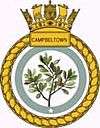HMS Campbeltown (F86)
_at_HMNB_Devonport.jpg) HMS Campbeltown at HMNB Devonport in September 2008 | |
| History | |
|---|---|
| Name: | HMS Campbeltown |
| Operator: | Royal Navy |
| Ordered: | January 1985 |
| Builder: | Cammell Laird |
| Laid down: | 4 December 1985 |
| Launched: | 7 October 1987 |
| Commissioned: | 27 May 1989 |
| Decommissioned: | 7 April 2011 |
| Homeport: | HMNB Devonport, Plymouth |
| Identification: |
|
| Motto: |
|
| Fate: | Scrapped October 2013 |
| Badge: |
 |
| General characteristics | |
| Class and type: | Type 22 frigate |
| Displacement: | 5,300 tons |
| Length: | 148.1 m (485 ft 11 in) |
| Beam: | 14.8 m (48 ft 7 in) |
| Draught: | 6.4 m (21 ft 0 in) |
| Propulsion: |
|
| Speed: |
|
| Complement: | 250 (max. 301) |
| Armament: |
|
| Aircraft carried: | |
HMS Campbeltown was a Batch 3 Type 22 frigate of the British Royal Navy. Built by Cammell Laird Shipbuilders Ltd. in Birkenhead, she was part of the third batch of Type 22s, which were considerably larger than their predecessors and incorporated more advanced weaponry after lessons learnt from the Falklands War. She was decommissioned on 7 April 2011.
History
Campbeltown's last deployment was a seven-month tour from 2007-2008 in the Persian Gulf, where she operated in support of Operation Calash and Operation Telic.[3] In early 2004 the vessel was deployed as part of NATO's Standing Naval Force Atlantic. HMS Campbeltown entered refit in September 2008.
The ship's bell of the first HMS Campbeltown, a Second World War Town-class destroyer famous for her role in the St. Nazaire Raid, has been loaned from Campbelltown, Pennsylvania to the current Campbeltown for the duration of her Royal Navy service.[4]
Decommissioning
The Royal Navy announced in March 2011 that Campbeltown would be decommissioned on 7 April 2011.[5] She paid a final visit to her namesake town of Campbeltown, Argyll in March 2011 where a series of ceremonies, including a town centre parade by the ship's crew, took place to commemorate the end of the ship's active service.[6] Campbeltown made her final entrance to Plymouth on 31 March 2011 before decommissioning in a traditional ceremony on 7 April 2011.[7] She was laid up at Portsmouth and in July 2013 sold to Turkish company Leyal for demolition. She was towed to Turkey in Autumn 2013.[8]
The ship's bell has now been returned to Campbelltown, Pennsylvania.[9] The ship's bell made specifically for the latest HMS Campbeltown was given to Campbeltown, Kintyre, to be displayed in the town's museum until a future Campbeltown is commissioned.[10]
Affiliations
Campbeltown was affiliated with a number of military and civic bodies:[11]
- J Battery, 3 Regiment, Royal Horse Artillery
- No. 24 Squadron RAF
- Worshipful Company of Wax Chandlers
- Campbeltown, Argyll
- Campbelltown, Pennsylvania
- Springbank Distillery, Campbeltown, Argyll
- Birmingham Nautical Club
- TS Campbeltown
- Bridgewater Sea Cadet Corps
- Royal Marine Cadet Corps, Bradfield College, Reading
- CCF Naval Section, Gordon's School, Woking
Footnotes
- ↑ "Royal Navy Bridge Card, February 2009" (PDF). Retrieved 20 June 2009.
- ↑ http://website.lineone.net/~david-carrington/Militaria/RoyalNavy/Major.htm
- ↑ "HMS Campbeltown". Royal Navy Live News. Archived from the original on 10 June 2008. Retrieved 27 May 2008.
- ↑ "HMS Campbeltown makes final visit to namesake town". UK Ministry of Defence. Retrieved 26 March 2007.
- ↑ Navy News (11 March 2011). "Campbeltown says her goodbyes". Retrieved 27 March 2011.
- ↑ "HMS Campbeltown". BBC News. BBC. 9 March 2011. Retrieved 16 March 2011.
- ↑ "Crew of frigate HMS Campbeltown say farewell". BBC News. BBC. 7 April 2011. Retrieved 7 April 2011.
- ↑ "Royal Navy frigates sold off for scrap for £3m". BBC News. 26 July 2013. Retrieved 13 August 2013.
- ↑ "World War II ship bell returns to Campbelltown". The Patriot-News. pennlive.com. 4 July 2011. Retrieved 8 July 2011.
- ↑ "The first HMS Campbeltown's Ship's Bell and the other Campbelltown". For Argyll. 4 July 2011. Retrieved 11 March 2011.
- ↑ "HMS Campbeltown affiliations - Royal Navy Website". Retrieved 20 June 2009.
